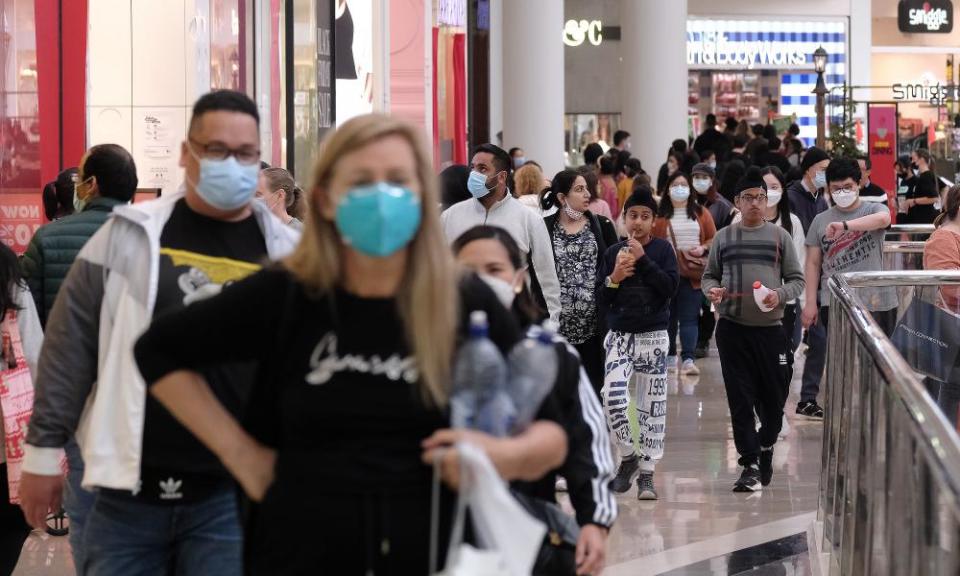The economy is getting back to normal? We don’t even know what that looks like any more

Wednesday’s GDP figures will likely be the second worst ever recorded in Australia, but more than anything they will highlight an economy still massively affected by the pandemic.
Whenever I hear talk about how we are moving on from the pandemic and things might be getting back to normal and so perhaps we need to start focusing on other things such as inflation or government debt, I draw people’s attention to the retail trade figures.
The latest figures came out last Friday and while I usually would rhapsodise about monthly or quarterly growth, let the graph of the total retail turnover tell the story:
If the graph does not display please click here
You don’t need to be an economist to know that something weird is still happening out there.
From 1982 until February 2020, retail trade would on average go up or down each month by 0.7%. In the 20 months since the pandemic hit, only twice has retail trade either risen or fallen by less than that amount.
In October it rose 4.9% in a month – a level that aside from the months around the introduction of the GST in 2000 had never happened before the pandemic, but which is only the fourth biggest increase since Covid-19 arrived.
Things are not even close to business as usual.
And of course the retail situation varies greatly depending on whether you’re selling goods like hardware, furniture or recreational goods, or you’re offering hospitality services in cafes, restaurants and takeaway:
If the graph does not display please click here
This wildness flows through to the national accounts and GDP figures.
On Monday the latest business indicators were released and showed a massive range in company profits.
Profits in the construction industry, off the back of government subsidies, jumped 20%, while the they fell 13% in the accommodation and food services industry, and 25% in the administrative and support industry, following business lockdowns and people working from home.
Wages overall fell 0.8% in the quarter, with a 1.0% fall in the non-mining sector of the economy:
If the graph does not display please click here
The biggest news from the business indicators was the change in inventories.
Inventories are essentially unsold items held by businesses. In the September quarter they fell 1.9%:
If the graph does not display please click here
As a general rule, when inventories fall it means that businesses are selling their stock and not seeking to replenish it for future sales.
Falling inventories detract from GDP growth. So great was the fall in the September quarter, it alone will cause the economy to shrink around 0.7 percentage points.
Off the back of that larger than expected fall in inventories, Shane Oliver from AMP Capital now expects GDP to decline 3.1% in the September quarter. That would flow through to annual growth of around 2.7% – well down on the (truly abnormal) 9.6% growth last quarter:
If the graph does not display please click here
But as is often the case with economics, the fall in inventories is not all bad.
While it is a bad sign when companies run down their stock, once things improve (and open up) they will again need to build up that stock, and that in turn spurs economic growth.
This is where the inflation concerns do arise, given international supply blockages could mean that businesses will struggle to have enough stock to sell to customers. In that case prices will rise.
But all of this is a bit tough to predict.
As those who are planning interstate Christmas holidays will know, there is little confidence in predicting what will happen three weeks from now, let alone three months later or the next year.
This brings us to the latest private capital expenditure figures, which also came out last week. While the September quarter was affected by lockdowns, what was most interesting were the latest estimates for investment in the 2021-22 financial year.
There was a strong increase in expectations for non-mining investment over this time last year. While that is good, it really doesn’t even make up for the falls last year.
Even worse, the increase does not appear due to any expected strength in the economy, but is largely driven by the instant asset write-off policy, which allows small businesses to write off a range of machinery such as new work vehicles and IT equipment:
If the graph does not display please click here
As Michael Pascoe noted, there’s only so many utes and laptops a business can buy. Much like the fall in inventories now means a build-up later, the big boost in machinery and equipment investment now means less later.
It all makes for an economy still very much buffeted by the pandemic waves.
Wednesday’s figures are going to be bad. And there will be an attempt to suggest that it is all in the past and that things are on the improve.
But while the figures will show an economy far from normal, we still do not know for sure what the “normal” economy will look like.
Whether it be spending on services or goods, or whether it be investing and house prices once interest rates begin to rise, there remains much that is in flux.

 Yahoo Finance
Yahoo Finance 